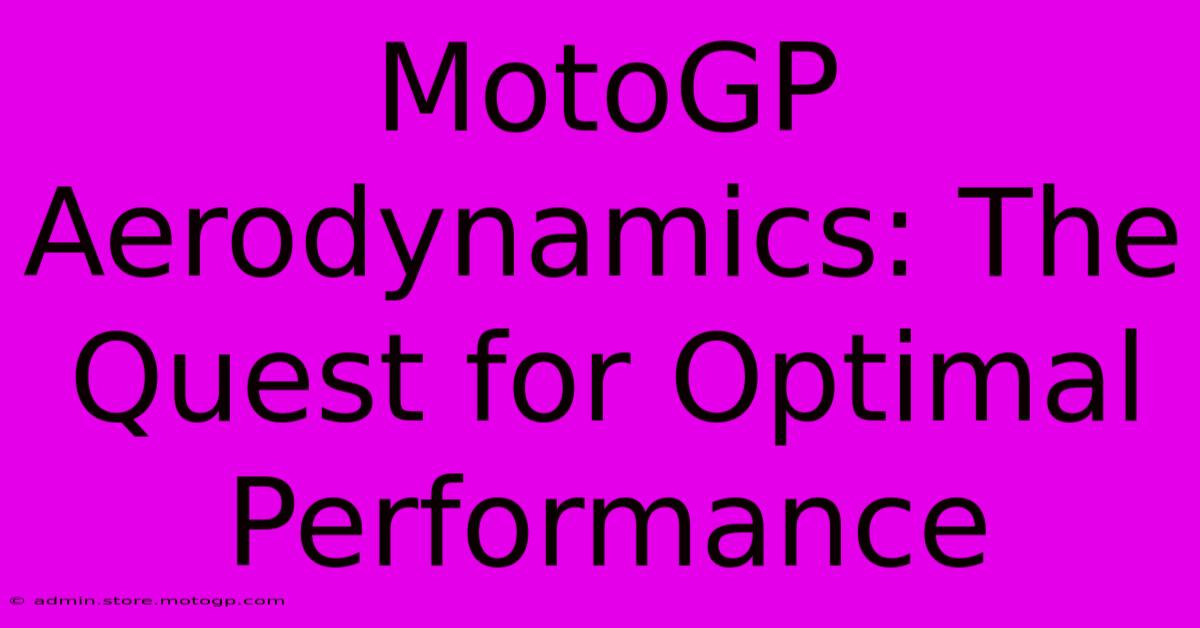MotoGP Aerodynamics: The Quest For Optimal Performance

Table of Contents
MotoGP Aerodynamics: The Quest for Optimal Performance
MotoGP racing is a relentless pursuit of speed and precision. Every millisecond counts, and every advantage, no matter how small, can be the difference between victory and defeat. In this high-stakes environment, aerodynamics plays a crucial role, shaping the performance and handling of these incredible machines. This article delves into the fascinating world of MotoGP aerodynamics, exploring the science behind the wings, winglets, and other aerodynamic devices that help riders conquer the track.
Understanding the Aerodynamic Challenges
MotoGP bikes, traveling at speeds exceeding 200 mph (320 km/h), face significant aerodynamic forces. These forces, primarily drag and downforce, directly impact the bike's stability, handling, and overall speed.
Drag: The Enemy of Speed
Drag is the resistance a moving object encounters from the air. In MotoGP, reducing drag is paramount to achieving higher top speeds. Every component, from the fairings to the rider's suit, contributes to the overall drag coefficient. Minimizing this coefficient is a constant focus for engineers, utilizing computational fluid dynamics (CFD) and wind tunnel testing.
Downforce: The Grip Booster
While drag is the enemy, downforce is a valuable ally. Downforce, the aerodynamic force pushing the bike towards the track, significantly improves grip and stability, especially through corners. This allows riders to lean further and maintain higher speeds while navigating turns. The balance between generating sufficient downforce without creating excessive drag is a critical design challenge.
The Evolution of MotoGP Aerodynamics
The development of aerodynamic devices in MotoGP has been a continuous process of innovation. Early bikes relied primarily on the shape of the fairings to generate downforce. However, the increasing speeds and demands of the sport led to the introduction of more sophisticated aerodynamic aids.
The Rise of Wings and Winglets
The introduction of wings and winglets marked a significant turning point. These aerodynamic appendages, strategically placed on the fairing, generate substantial downforce, enhancing stability at high speeds and allowing for greater cornering speeds. The design and placement of these components are subject to rigorous testing and refinement.
Beyond Wings: A Deeper Dive into Aerodynamic Solutions
Modern MotoGP bikes utilize a variety of sophisticated aerodynamic solutions beyond wings and winglets. These include:
- Streamlined Fairings: Engineered to minimize drag and optimize airflow around the bike.
- Aerodynamic Appendages: Small, strategically placed devices designed to manage airflow and enhance downforce in specific areas.
- Underbody Aerodynamics: Careful design of the underbody to control airflow and enhance downforce.
- Rider Positioning and Suit Design: Even the rider's position and the design of their suit contribute to the bike's overall aerodynamic performance.
The Ongoing Pursuit of Perfection
The quest for optimal aerodynamic performance in MotoGP is a never-ending journey. Teams constantly refine their designs, leveraging advanced simulation tools and meticulous wind tunnel testing to gain even the smallest advantage. The interplay between drag reduction and downforce generation remains a delicate balancing act, with engineers constantly seeking the sweet spot that maximizes performance.
Future Trends: Expect to see further refinements in existing technologies and the exploration of new aerodynamic concepts. The pursuit of efficiency and performance in MotoGP continues to push the boundaries of what's possible in motorcycle aerodynamics.
Conclusion
MotoGP aerodynamics is a fascinating blend of science and engineering. The constant drive for improvement, fueled by the intense competition, leads to continual advancements in this critical area of motorcycle racing. Understanding the principles of drag and downforce, and the various aerodynamic devices employed, provides a deeper appreciation for the technological marvel that is a modern MotoGP machine. The quest for optimal performance is an ongoing saga, with each race offering a new chapter in this thrilling pursuit of speed and precision.

Thank you for visiting our website wich cover about MotoGP Aerodynamics: The Quest For Optimal Performance. We hope the information provided has been useful to you. Feel free to contact us if you have any questions or need further assistance. See you next time and dont miss to bookmark.
Featured Posts
-
Moto Gp Sprint Results Who Conquered The Short Track
Feb 19, 2025
-
Unveiling The Gems Of The Queen Circuit
Feb 19, 2025
-
Free Moto Gp Live Stream Get In On The Action
Feb 19, 2025
-
Moto Gp Streams The Ultimate Moto Gp Viewing Experience
Feb 19, 2025
-
Cota Track Day Your Gateway To Racing
Feb 19, 2025
